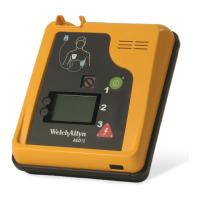User Manual Safety 5
Defibrillator and Electrode Pads
Explosion
Electrical Shock or Fire Hazard
Improper Device Performance
WARNING Explosion hazard
Possible explosion hazard if used in the presence of concentrated oxygen or
flammable anesthetics.
WARNING No internal, operator-serviceable parts
Do not open unit, remove covers, or attempt to repair the Welch Allyn
AED 10. All servicing must be performed by qualified personnel.
WARNING Improper use can cause injury.
The Welch Allyn AED 10 contains an automatic disarm of the stored energy. If
the operator has not delivered the energy to a patient or a test load, an
internal timer will disarm the stored energy. This stored electrical energy can
potentially cause death or injury if discharged improperly. Follow all
instructions in this users manual.
Caution Do not immerse or expose the Welch Allyn AED 10 to water or other
liquids.
Do not use the defibrillator if unit has been immersed in liquid or if excessive
condensation is visible on the device.
Caution Conductive parts should not contact other conductive parts including
the earth.
WARNING Properly use electrode pads.
Do not attempt to warm the electrodes with a heat source greater than 35° C
(95° F). Do not immerse or clean electrodes with alcohol or solvents. Do not
perform chest compressions (CPR) through electrodes. These actions may
damage the electrode pads cause the AED 10 to function improperly.
WARNING Use only accessories approved by Welch Allyn.
Do not use defibrillation pads, batteries, and other accessories not approved
by Welch Allyn. Use of unauthorized accessories may cause the device to
operate improperly and provide false measurements. Follow all labeling
instructions on the defibrillation pads and the battery.

